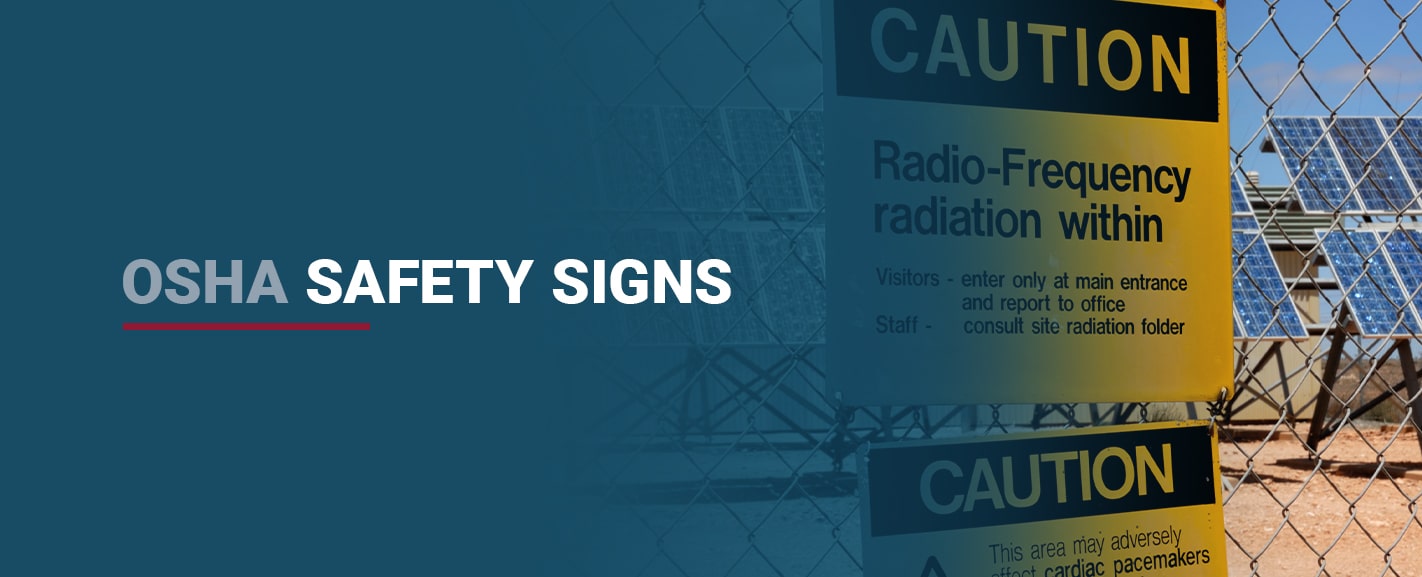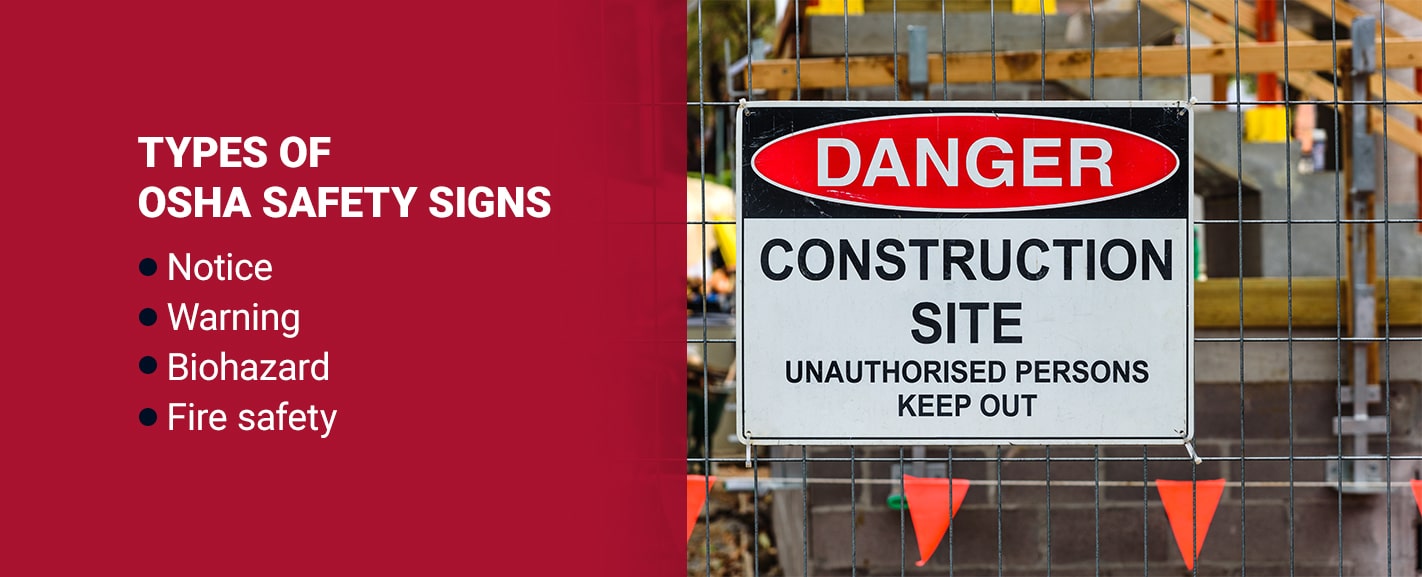
Safety signs promote workplace safety across industries. They warn about potential hazards and provide valuable safety information, reducing the risk of accidents and injuries.
OSHA has developed regulations and specifications for safety signs, standardizing their use, design, and wording. While some industries may include additional requirements, there are several essential standards all safety signs must follow.
OSHA Safety Sign Classification
OSHA classifies safety signs according to their use and the potential hazard’s level of severity:
- Danger: Danger signs indicate an immediate danger that requires special precautions, such as areas with risks of high voltage or exposure to hazardous chemicals. This classification identifies a hazardous situation that may potentially cause serious injury or death. You should only use these signs for extremely hazardous conditions.
- Caution: Caution signs signal a warning against possible hazards and unsafe practices. For example, a caution sign might identify an area that contains hazardous waste or warn people not to enter the area without eye and ear protection. You should use this classification of signs when there’s a potential for minor to moderate nonfatal injuries.
- Safety instruction: Safety instruction signs communicate general safety instructions or suggestions. For example, these signs might indicate an area restricted to authorized personnel only or identify an area to pick up personal protective equipment (PPE). This classification of signs provides general instructions, communicates procedures, and gives information.

Types of OSHA Safety Signs
The three main OSHA safety sign classifications contain several types of signs that create a safer environment both directly and indirectly, including:
- Notice: You can consider notice signs as a category of safety instruction signs. While these signs convey non-safety instructions, procedures, directions, and rules, their information can still help promote safe practices. For example, a notice sign identifying an out-of-order piece of equipment can prevent potentially hazardous attempts to use it.
- Warning: Warning signs communicate a hazard level between danger and caution. Signs in this category use the same template as caution signs, though their colors and signal words are different.
- Biohazard: Biohazard signs and labels indicate potential exposure to blood or other infectious materials. HIV or HBV research laboratories must post biohazard signs in appropriate areas. All other workplaces where exposure may be an occupational hazard must label certain items and areas. OSHA requires labels on any containers, including refrigerators and freezers, used to transport, store or ship potentially infectious materials.
- Fire safety: Fire safety signs are in place to identify fire exits and mark the location of emergency firefighting equipment. OSHA also requires employers to post signs identifying areas where the agents used in fixed extinguishing systems might pose a health and safety hazard.
OSHA Safety Sign Requirements
Using standardized elements lets signs convey important information quickly and clearly. A black, red, and white sign with an exclamation mark tells employees at a glance that there’s an immediate danger in the area. Hanging or installing signs at the same height makes them easier to spot, and requiring readability at a minimum distance ensures their information is clear and legible.
OSHA safety sign regulations cover:
- Application: These regulations offer guidance for how, when and where to use different signs. For example, danger signs should convey an immediate danger rather than a potential hazard, while safety instruction signs should contain information unrelated to potential injuries or accidents.
- Design: OSHA’s safety sign design regulations establish universal standards and individual templates for the three major classifications. All signs must have blunt or round corners, dull edges, and safely located fastening devices.
- Symbols and pictograms: A sign’s information can appear as a pictogram or symbol, written text, or both. Additionally, OSHA sometimes requires specific symbols for corresponding hazards or situations, such as the presence of biohazards.
- Wording: OSHA has several general rules for wording on safety signs. Wording that complies with OSHA safety sign regulations is easy to read and understand. The information must be accurate, sufficient and concise, and present a positive suggested action.
- Lettering: A sign’s signal word is the word meant to attract the reader’s immediate attention and communicate the most important message. Since adopting ANSI Z535.2-2011 standards, OSHA regulations have dictated that signal words must be readable from a safe distance. While the distance varies by hazard, all signal words must be readable from at least 5 feet away.
Placement of OSHA Safety Signs
OSHA regulations also cover where employers should place safety signs.
Signs should be as close to the relevant hazard, location, or equipment as possible to identify the area clearly. Employers should choose a spot where the sign is still visible from a safe distance.
Safety signs should be away from any movable objects, well-illuminated, and protected against fading or other damage.
Color-Coding of OSHA Safety Signs
ANSI and OSHA regulations require safety signs to use specific colors for different types of information. This color-coding creates a uniform appearance, letting viewers immediately understand the risk level. OSHA color classifications include:
- Red: Red indicates “danger” or “stop” and is used for danger signs, emergency stops, flammable liquid, and fire equipment.
- Orange-red: Orange-red signs are used exclusively for biohazards. Labels must include the biohazard symbol in a contrasting color.
- Orange: Orange is the color of warning signs and work zone markings. These signs can indicate potential injury from machine parts, electrical hazards, or low clearance.
- Yellow: Yellow caution signs point out hazards and warn against unsafe behaviors. For example, a yellow a-frame sign might identify a wet patch of the floor, and a wall sign might remind employees to use eye protection in a certain area.
- Green: Green is used for safety instruction signs. These signs might mark the location of first aid and other medical equipment or list general safety guidelines.
- Blue: Blue is most commonly used for notice signs. This color indicates general information unrelated to the risk of accidents or injuries. These signs can include procedure instructions, clearance information, and maintenance rules.
OSHA also designates required color combinations for their three main sign classifications:
- Danger: Danger signs must be black, red and white.
- Caution: Caution signs must have a black panel with yellow letters. The background must be yellow, and any letters on the background must be black.
- Safety instruction: Safety instruction signs must have a white background with black letters. The top panel must be green and the signal word must be set in white letters.
View NASP’s Safety Trainings Online
If you want to learn more about OSHA requirements and regulations, the National Association of Safety Professionals (NASP) can help.
NASP offers classroom, site-specific and online training and professional certifications for safety professionals. While the approaches are different, you’ll earn the same certification however you choose to learn. Our classroom courses provide networking opportunities, direct interaction with the instructor and an emphasis on training methodologies. If you want to save on travel costs and move through at your own pace, our online courses might be for you.
Learn more about our certification programs and development courses, all of which meet or exceed OSHA requirements, and browse our online course catalog to get started today.






